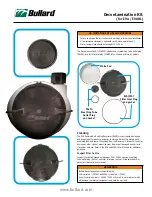
SSR 30/100 / SSR 30/100 B
12
Maintenance and Cleaning
GB
4
Maintenance and Cleaning
4.1
Maintenance Instructions
To maintain readiness for use, the device must be inspected regularly, checked for integrity, tightness
and, if necessary, cleaned [do not use metal brushes!]. Other maintenance measures are not required.
As the device contains a chemical which is sensitive to moisture, it is packed in an airtight container
and is sealed at the factory.
The frequency of inspection depends on the device load [
chapter 4.4].
For used and/or opened devices, the chemical canister must always be replaced, reuse is not
permitted. Internal checks and any repairs to the devies are to be carried out by the MSA Customer
Service or authorized service centers.
4.2
Return of Used Device
For return of used or opened devices, observe the following:
-
Pack the device and components in the device containers only after they have cooled down and
are dry.
-
No organic substances must enter the chemical canisters [e.g. solvents, oils, etc.].
-
Observe transport regulations [
chapter 5].
If the complete device cannot be packed in the container, the following procedure is required:
-
Remove the chemical canister from the device:
(1)
Therefor loosen the clamp and remove the breathing bag and breathing tube.
(2)
Pack the chemical canister inside the container and seal with the original locking assembly of
the container.
Do not use finely cutted filling material.
-
Place the other components of the device with the closed container in a carefully packed package.
-
The components must be complete and undamaged.
4.3
Tightness Test
The tightness test of the device is carried out using the MSA tightness tester for chemical oxygen
breathing protection apparatus. Detailed descriptions of the structure, function, use and maintenance
of the tightness tester can be taken from the relevant operating manual of the tightness tester
[
chapter 8].
The tightness test of the device is carried out as follows:
(1)
Push the device without any straps into the tightness tester in such a way that the cover points
towards the door.
(2)
Close the door and lock.
(3)
Set timer to 90 s.
(4)
Create overpressure with the lever, i.e. push the lever downwards until it engages and start the
timer at the same time.
(5)
After 30 seconds, cover the black pointer with the red pointer.
(6)
After a further 60 seconds, the timer signals the end of the test period. Then read the pressure
difference between the red and the black pointers.
The device is tight if the black pointer remains in the prescribed pressure range and if the pressure
difference is no more than 5 mbar.
If the pressure drop is more than 5 mbar, the unit must be replaced.



























